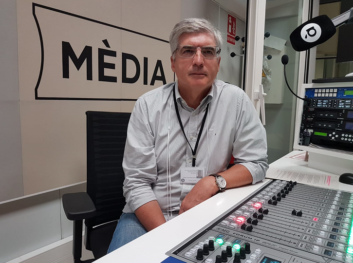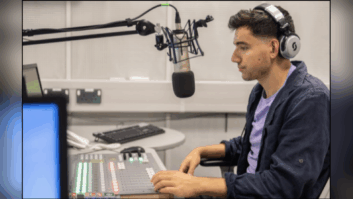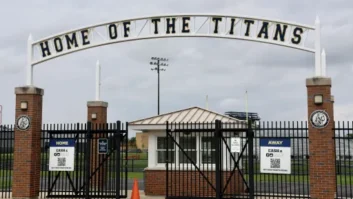
The author is support engineer at À Punt Radio.
VALENCIA, Spain — À Punt Radio is part of the Corporació Valenciana de Mitjans de Comunicació. In the recent past we have been supplied by AEQ with an IP audio network based on Dante technology.
We have worked really hard to define and implement a solution that is flexible, reliable, easy to use and maintain, and long-lasting all at the same time.
The Central Control Room
Though the system features automatic Dante redundancy, we are planning a parallel AES/EBU digital-audio network to provide for an emergency audio contingency that would allow operation and broadcasting to continue via some simple patch switching.
Routing is performed by an AEQ BC2000 digital audio matrix with TDM technology, IP connected with Dante to the studios. The destination is Forum Split digital mixers. Two of these studios, dedicated to live music and music editing, incorporate an additional Yamaha TF1 console connected through the Dante network.
In the central control room are two AEQ SysTel IP broadcast telephone systems, three audio codecs, two radio multi-receivers, two DVB-S2 (HD satellite) and DVB-C/T (cable and DVB-T, both in HD) receivers, and two TV sets, monitoring selector, two dual VU meters, two EBU monitors, two FM program and one streaming processors.
Also, there are two main monitors for central control room listening, the BC 2000D audio matrix and two Netbox 32 audio-over-IP interfaces. The audio matrix installed is a scalable AEQ BC2000D router. It mixes, distributes and processes audio using TDM technology, sized with a total of 352 inputs and 352 outputs, 256 of which are AoIP Dante, 64 are AES/EBU digital and 32 are analog.
Eight patch panels are the matrix and AoIP interface inputs and outputs from and to analog and AES/EBU digital equipment connected to the matrix and AoIP. Also, an AES/EBU input and output from each studio is connected, providing an emergency wiring path.
There are four deployed IP networks: main Dante audio-over-IP network; a secondary Dante network; voice/telephony IP network connected to the WAN provided by the telco; and the control network for all the devices.
The CPUs for all computers can be seen in the central control room: the ones providing service in the central control room and the ones serving the controls, studios and booths using KVM extenders.
Typical wiring between the central control room and each studio is composed of:
- Two video distribution cables (plus four more for the cameras in the Studios 1 and 3);
- 16 Ethernet cables for primary Dante AoIP; secondary Dante AoIP; IP telephony system’s handset; studio’s AES/EBU audio input/output; four KVM extensions; two cables for the device IP control network; one more for the audio matrix control panel; and five spare cables.
For journalist booths, wiring is simpler, with only eight Ethernet cables plus the two video ones.
A design criterion shared by AEQ and À Punt Radio is not to skimp on Ethernet wiring so the networks can be physically separated, greatly simplifying configuration and maintenance, reducing failures, providing physical redundancies and leaving available infrastructure left for future implementations.
[Read “How to Choose Your Next Console”]
Four radio studios have been installed around a Forum IP Split broadcast digital mixer, with 16 faders, and a separate audio engine. Forum Screen software application was added to help control, as well as an R128 loudness meter. The console communicates with the central control room using Dante, Netbox interfaces and other AoIP devices. It features analog microphone, line and headphone inputs/outputs and AES/EBU I/O to connect to the rest of equipment.
Also, two studios have been equipped with a camera automation system to produce visual radio by means of data command through the mixer’s Ethernet interface.
Communications management (including VoIP telephony and IP/ISDN audio codecs) is performed using their respective control software. SysTel IP management application was installed on a PC with touchscreen. Audio codecs are controlled using AEQ’s Control Phoenix, a dedicated piece of software.
All the required local devices (CD and USB media players, effects modules, active monitors, etc.) have also been included.
Journalist Booths
For radio journalists Capitol mixing consoles are installed.
A TV set connected to the console, allows for direct recording of radio and TV broadcasted signals. A Tascam playback/recording unit is used to insert and extract audio files. A broadcast telephone system terminal, allows interfacing calls with the automation system or sending them on air.
Besides the central control room matrix input and outputs, audio signals from any other location on the network can be requested for recording and/or editing. In the same way outgoing lines to the matrix allows the sharing of live work with any other studio or even putting it on air directly if required.
Installation of the equipment was by AEQ System Engineering Dept. under the coordination of Bernardo Saiz, supervised by Francisco Calabuig and the rest of engineers at À Punt Comunicació.
Radio World User Reports are testimonial articles intended to help readers understand why a colleague chose a particular product to solve a technical situation.
For information in the United States, contact AEQ Broadcast International in Florida at 1-800-728-0536 or visit www.aeqbroadcast.com. Elsewhere contact Gustavo Robles at AEQ in Spain at +34-91-686-1300 or visit www.aeq.eu.







